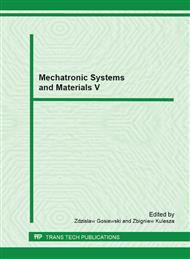p.43
p.49
p.55
p.61
p.67
p.73
p.79
p.85
p.93
The Influence of Diagnostic Signal Measurement Period on Blades Technical Condition Images Determined from Phase Shift Difference
Abstract:
In the article, new method of monitoring of rotor machine blades technical condition is presented. This method is based on diagnostic model φT12T01 [ which uses phase shift difference of signal fragments resulting from blade operation y (t) during blade recession from sensor and during approach of blade tip towards the sensor as well as signal of its environment x (t) described using proper distribution. The assumed diagnostic model also indirectly includes actual blade environment x (t) without necessity of its measurement [3,. Contactless inductive sensor constantly measures the signal of operating blade transition below the sensor. However, several difficulties with determination of last sample of blade receding from the sensor with first sample of blade approaching the sensor exist. Additionally the problem occurs with measurement of space between blades. So far, the case was solved by use 90% of this space range (in order to eliminate the overlapping of adjacent blades signals). Hence the problem of assessment of measurement period breadth on obtained models (images) of blades. The possibility of blade damage detection by analysis of less than 90% signal course was tested.
Info:
Periodical:
Pages:
67-72
Citation:
Online since:
March 2013
Authors:
Keywords:
Price:
Сopyright:
© 2013 Trans Tech Publications Ltd. All Rights Reserved
Share:
Citation:


